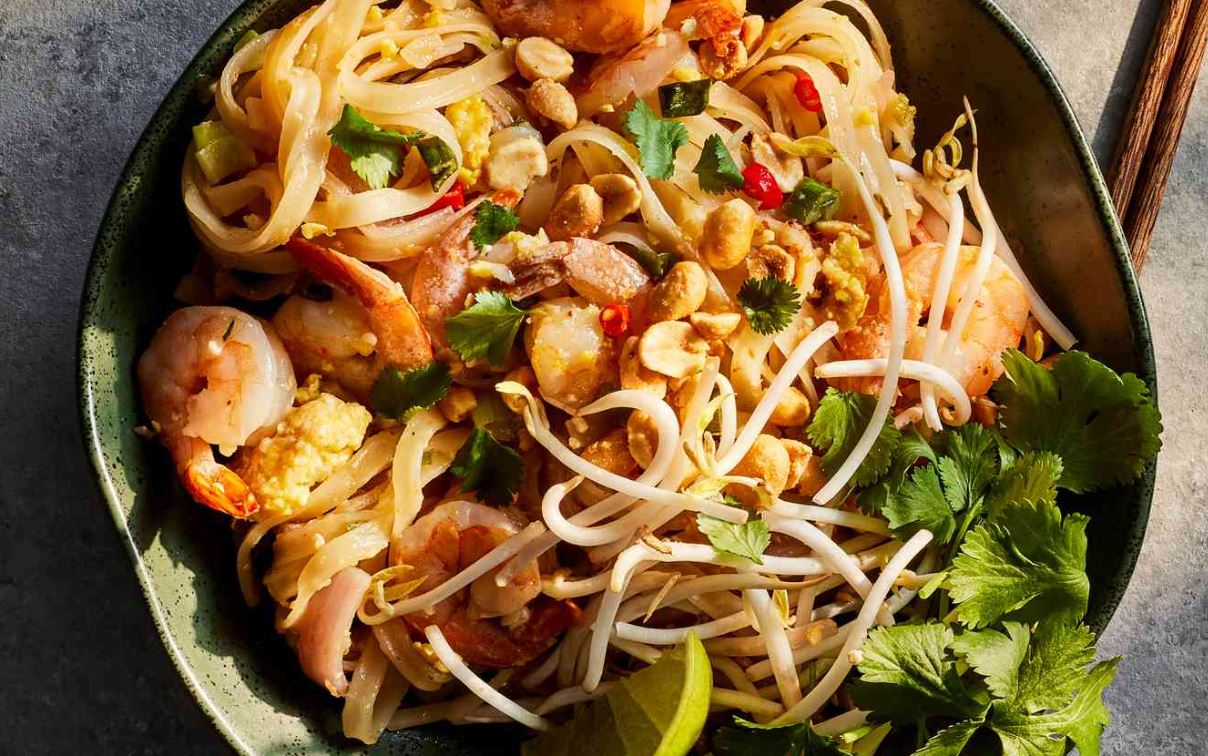Pad Thai, a popular dish from Thailand, has become a favorite worldwide due to its flavorful combination of sweet, salty, and sour tastes. This stir-fried noodle dish often features rice noodles, proteins like shrimp or tofu, and a blend of vegetables and sauces. But, Is Pad Thai Gluten Free?
Many assume that Pad Thai is gluten-free because rice noodles are naturally free from gluten. However, that’s not always the case. Whether Pad Thai is gluten-free depends on the specific ingredients used in the preparation.
Table of Contents
What is Pad Thai?
Pad Thai is a classic Thai dish known for its complex yet balanced flavor profile. The dish primarily consists of rice noodles, which are stir-fried with a variety of ingredients. Traditionally, these include scrambled eggs, tofu or shrimp, bean sprouts, peanuts, and green onions. The dish is brought together with a flavorful sauce made from tamarind, fish sauce, and a sweetener, often sugar.
Pad Thai’s appeal lies in its ability to blend multiple flavors — sweet, savory, sour, and sometimes spicy — into a single dish. It’s commonly enjoyed as street food in Thailand but has become a staple in Thai restaurants worldwide.
While rice noodles, the base of Pad Thai, are naturally gluten-free, other ingredients can introduce gluten. Soy sauce is a common addition, and unless it’s a gluten-free version, it contains wheat. Additionally, certain fish sauces may include gluten, and cross-contamination is another risk in restaurants. For those with gluten sensitivities, it’s important to ensure that the Pad Thai you’re consuming is prepared with gluten-free ingredients.
Is Pad Thai Gluten Free?
Rice noodles are a primary ingredient in Pad Thai and are naturally gluten-free. These noodles are made from rice flour and water, which makes them a safe choice for individuals avoiding gluten. The gluten-free nature of rice noodles is one reason why many consider Pad Thai to be a naturally gluten-free dish.
However, while the noodles themselves are safe, it’s important to ensure the entire dish is free from gluten. Some restaurants might substitute rice noodles with wheat-based noodles in different versions of the dish, so confirming the type of noodles used is crucial. Additionally, cross-contamination can occur if rice noodles are cooked in the same pots or pans as gluten-containing ingredients.
When buying rice noodles for homemade Pad Thai, make sure to check the label for certification, especially if you’re highly sensitive to gluten. Some brands may process their noodles in facilities that also handle gluten products, which increases the risk of contamination. In general, though, rice noodles are considered a reliable option for gluten-free diets.
Potential Gluten Sources in Pad Thai
While the rice noodles in Pad Thai are gluten-free, the other ingredients in the dish can sometimes introduce gluten. One of the most common culprits is soy sauce, which often contains wheat. Traditional soy sauce is made with fermented soybeans and wheat, making it unsafe for those on a gluten-free diet. To avoid this, gluten-free tamari or coconut aminos are often used as alternatives, as they provide a similar flavor without the wheat.
Another potential source of gluten is fish sauce. Although fish sauce is generally gluten-free, certain brands may include additives or preservatives that contain gluten. It’s important to check the label or inquire about the specific fish sauce used, particularly when dining out.
Oyster sauce can also pose a risk in some variations of Pad Thai, as it may contain gluten. If you’re dining at a restaurant, be sure to ask if this sauce is part of the recipe.
Additionally, cross-contamination is a major concern in restaurant kitchens. Even if the ingredients used are gluten-free, there’s a possibility that they could come into contact with gluten-containing foods through shared equipment or preparation areas. When ordering Pad Thai at a restaurant, it’s essential to inquire about how the dish is prepared to ensure it’s safe for a gluten-free diet.
Frequently Asked Questions (F.A.Q)
Is traditional Pad Thai gluten-free?
Traditional Pad Thai isn’t always gluten-free. While rice noodles are naturally gluten-free, the sauces, particularly soy sauce and sometimes fish sauce, can contain gluten. Restaurants often use regular soy sauce, which includes wheat. So, it’s best to ask or make sure the dish uses gluten-free alternatives like tamari.
Can I substitute ingredients to make Pad Thai gluten-free?
Yes, it’s easy to make gluten-free substitutions. You can replace regular soy sauce with gluten-free tamari or coconut aminos. Check the fish sauce and other sauces to ensure they don’t contain gluten. Homemade Pad Thai sauce is another great option to control the ingredients.
How do I avoid cross-contamination when eating out?
When dining out, you should ask whether the restaurant uses separate cookware and utensils for gluten-free dishes. Cross-contamination can occur if the same pans, spatulas, or woks are used for preparing dishes with gluten. Inquiring about the kitchen’s handling process can help avoid any gluten exposure.
Wrapping Up
To enjoy Pad Thai safely on a gluten-free diet, it’s crucial to pay attention to the ingredients and preparation methods. While rice noodles themselves are gluten-free, other components, like soy sauce and fish sauce, can introduce gluten into the dish. Dining out requires extra caution to avoid cross-contamination, so always ask the restaurant about their cooking methods.
Read Also: Is Tempura Gluten Free?
